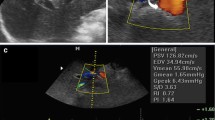Abstract
Post-mortem studies suggest that liver metastases obtain the majority of their nutrition from the hepatic artery, however, cytotoxic arterial perfusion with or without hepatic-artery ligation has not proved entirely successful as a therapeutic regime. In this study we have measured blood flow into colorectal liver metastases using xenon-133 (133Xe) clearance in patients undergoing surgery for colorectal cancer. Pre-operative measurements after direct parenchymal injection gave a mean flow of 41.5 +/- 22.5 ml/min/100 g which after hepatic arterial occlusion perfusion, was reduced to a mean of 5% of the pre-occlusion value. Dynamic blood-flow studies using the gamma camera were performed in the post-operative period by administration of 133Xe into both hepatic arterial and portal venous catheters. The initial distribution images indicated a predominant arterial perfusion to the metastases, but after hepatic-artery ligation, portal-vein perfusion to the metastases was statistically significantly increased. Hence, a compensatory haemodynamic mechanism exists which may account for the poor results of hepatic-artery ligation and perfusion alone.
Similar content being viewed by others
Rights and permissions
About this article
Cite this article
Taylor, I., Bennett, R. & Sherriff, S. The blood supply of colorectal liver metastases. Br J Cancer 38, 749–756 (1978). https://doi.org/10.1038/bjc.1978.283
Issue Date:
DOI: https://doi.org/10.1038/bjc.1978.283
- Springer Nature Limited
This article is cited by
-
Anästhesiologisches und postinterventionelles Management bei perkutaner hepatischer Melphalanperfusion (Chemosaturation)
Die Anaesthesiologie (2023)
-
Preparation and preliminary bioevaluation of 68Ga-oxine in lipiodol as a potential liver imaging agent
Journal of Radioanalytical and Nuclear Chemistry (2017)
-
18F-FDG PET/CT predicts survival after 90Y transarterial radioembolization in unresectable hepatocellular carcinoma
European Journal of Nuclear Medicine and Molecular Imaging (2017)
-
Percutaneous Isolated Hepatic Perfusion for the Treatment of Unresectable Liver Malignancies
CardioVascular and Interventional Radiology (2016)
-
The role of early 18F-FDG PET/CT in prediction of progression-free survival after 90Y radioembolization: comparison with RECIST and tumour density criteria
European Journal of Nuclear Medicine and Molecular Imaging (2012)




